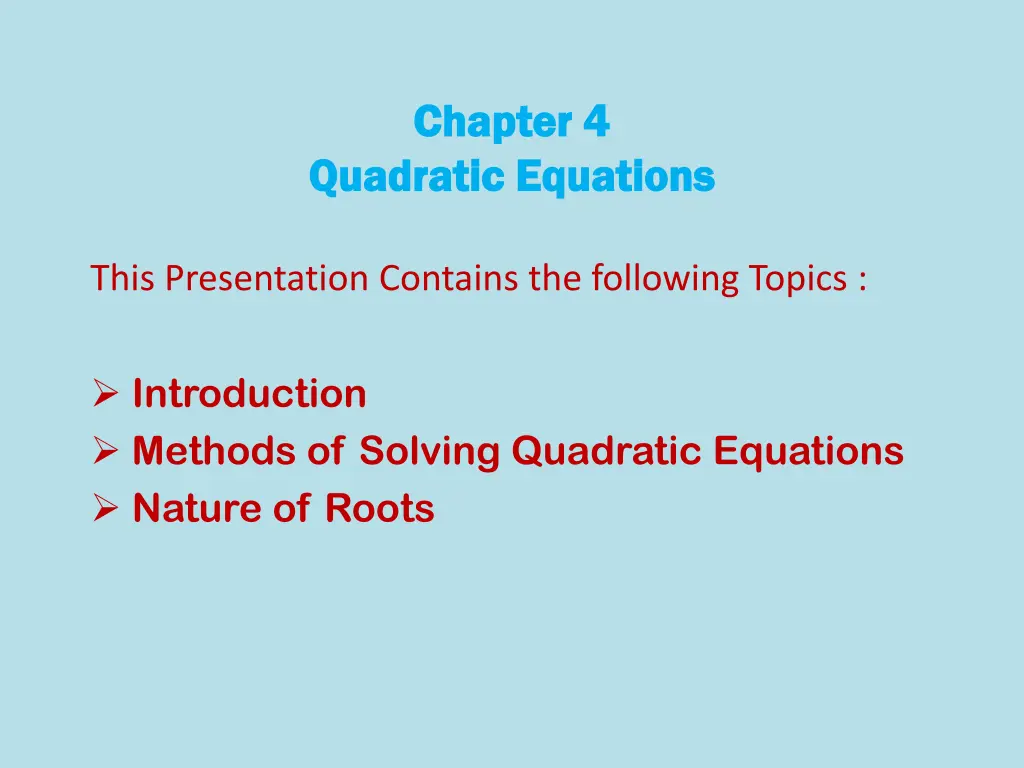
Quadratic Equations and Solutions Tutorial
"Learn about quadratic equations, methods for solving them, and how to find solutions using factorization. Explore examples and understand the nature of roots in quadratic equations."
Download Presentation

Please find below an Image/Link to download the presentation.
The content on the website is provided AS IS for your information and personal use only. It may not be sold, licensed, or shared on other websites without obtaining consent from the author. If you encounter any issues during the download, it is possible that the publisher has removed the file from their server.
You are allowed to download the files provided on this website for personal or commercial use, subject to the condition that they are used lawfully. All files are the property of their respective owners.
The content on the website is provided AS IS for your information and personal use only. It may not be sold, licensed, or shared on other websites without obtaining consent from the author.
E N D
Presentation Transcript
Chapter 4 Chapter 4 Quadratic Equations Quadratic Equations This Presentation Contains the following Topics : Introduction Methods of Solving Quadratic Equations Nature of Roots
Quadratic Equations:- Any equation of the form p(x) = 0 , where p(x) is a quadratic polynomial (polynomial of degree 2 ) is a quadratic equation. The standard form of the quadratic equation is ax2+ bx + c = 0, where a,b, and c are real numbers, and a 0. We should write the terms of p(x) in descending order of their degree. Eg. x2-5x + 6 = 0 is a quadratic equation. Other forms of quadratic equations are : i. When b = 0 , c 0, then the quadratic equation is of the form ax2 +c = 0. eg. 2x2-6 = 0. ii. When b 0 , c = 0, then the quadratic equation is of the form ax2+ bx = 0. eg. 3x2+ 5x = 0 . iii. When b = 0, c = 0, then the quadratic equation is of the form ax2 = 0. eg. x2=0
Methods of Finding Solution of Quadratic Equation Solution of quadratic equation means to find the roots of a quadratic equation. As the quadratic equation is a polynomial of degree 2, so it have two roots. There are three methods of finding the roots or solution of quadratic equation these are : (i) Fectorisation Method (ii) Method of Completing The Square. (iii) Quadratic Formulae.
Solution Of Quadratic Equation by Factorisation Method In this method we factorise the quadratic equation by splitting the middle term and then find the values of x. Working Rule : Let us consider the standard form of quadratic equation : ax2 + bx + c = 0, where a 0. Then follow these steps: Step 1 : Multiply a and c i,.e find ac , and then prime factorise a.c . Let say m and n are two factors of a.c. Step 2 : Split the middle term i.e b in terms of m and n such that there sum or difference is equal to a.c. For sum or difference we have to check the sign of c , if it is + then, add m and n, if it is then subtract m and n . Step 3 : After the above step our equation is now in the form ax2 + (m + n) x + c =0, Step 4 : Then open the bracket and multiply x by each i.e by m and n . And we get ax2+ mx + nx + c = 0 Step 5 : Finally factorise the equation by grouping and we get two factors , and then we can find the roots of the equation by equating them to 0.
Example : Solve the equation by factorisation method 2x2 7x + 6 = 0 Solution : We have given the equation 2x2 7x + 6 = 0 , Here we have a = 2, b = -7, and c = 6 ab = 6 x 2 = 12 , and sign of c i.e 6 is positive. So we have to find two factors of 12 such that there sum is 7 , which are 4 and 3 Now equation is 2 x2 ( 4 + 3 ) x + 6 =0 => 2 x2 4x 3x +6 =0 => 2x ( x 2) -3 ( x 2)= 0 => (x 2) . ( 2x -3) = 0 Now we got the two factors of given quadratic equation, and we have to find the roots . For this we put If (x 2) =0 if (2x 3) = 0 => x = 2 => 2x = 3 => x = 3/2. So we go the two values of x as 2 and 3/2 . So this is the method of factorisation by middle term spiliting .
Quadratic Formula Consider the equation ax2+ bx = c = 0, where a, b, and c are real numbers and a 0, Dividing the given equation by a, we get x2+ (a/b)x + c/a = 0 Now adding and subtracting (b/2a)2,we get x2+ (a/b) x + (b/ 2a)2- (b/ 2a)2+ c/a = 0 => ( x + b/2a )2= b2/4a2 c/a ( x + b/2a)2= (b2 4ac)/ 4a2 ( x + b/2a)2= (b2 4ac)/ 4a2 ( x + b/2a) = (b2 4ac)/ 2a x = -b/2a (b2 4ac)/ 2a x = [-b (b2 4ac)]/ 2a , which is known as quadratic formula.
Nature of The Roots of a Quadratic Equation As we know that the quadratic has two roots , their existance is depend on the value of (b2 a-4ac ), which is also known as the discriminent , and is denoted by D . There are three conditions due to which we can find the nature of the roots. If (b2 4ac ) > 0, i.e if D is positive , then the quadratic equation has two distinct real roots. If (b2 4ac ) = 0, then the quadratic equation has two equal real roots . iii. If (b2 4ac ) < 0, i.e if D is negative , then the quadratic equation has no real roots i. ii. **Note : It means that to find the nature of the roots of a quadratic equation, we have to find the value of D.






















